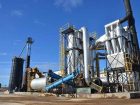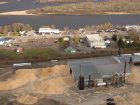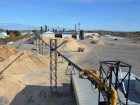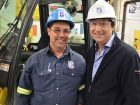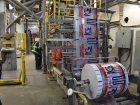
Granules LG: Quebec’s pellet leader
June 9, 2016
By Guillaume Roy
June 9, 2016 - "Twenty years ago, we produced 4,700 tons of pellets. We now produce as much in only two weeks,” Granules LG general manager Ken St-Gelais proudly states.
 The Granules LG pellet plant has made adjustments when needed Twenty years ago
The Granules LG pellet plant has made adjustments when needed Twenty years agoWith recent investments for improved automation and controls, the St-Félicien mill, in the northern Lac-Saint-Jean region, produced 120,000 tons in 2015. And it is expected to reach 125,000 tons in 2016.
“We have improved our productivity by eight per cent running on our same equipment,” St-Gelais explains.
Not bad for a $400,000 investment used to upgrade many 20-year-old controls, cabling and electricity devices. As a result, there is now less downtime and everything runs more smoothly.
“Investing in automation helped us standardize and increase the productivity, going from 2,000 tons per week two years ago to 2,350 tons per week today,” adds the mill manager, Carl Paul. All of these improvements were made internally.
“We are now running at full capacity, and it will be hard to increase our production,” St-Gelais adds.
Burnt Timber Recuperation
Last year, Granules LG also added a few conveyors to bring new types of materials into the mulching system, which was previously used to bring full burnt trees in the mill. In 2009–2010, Granules LG salvaged 50,000 m3 of burnt forest.
Back then, it seemed like a good way to increase the wood supply.
“But pellet prices went down and it never reached that summit again,” St-Gelais notes. Since pellet prices are about 10 per cent lower than in the late 2000s, harvesting and processing burnt wood is no longer profitable.
To stabilize the supply, Granules LG decided to buy chips instead and mulch it in the mill. “Maintaining our supply is always a challenge. We have few suppliers with many big companies controlling most of the sawmills in the region,” St-Gelais says.
Granules LG use dry and green softwood supplies to produce pellets. “To produce the best quality, we make sure the material has nine per cent humidity when it gets into the machines,” states production foreman Mathieu Lamontage.
To reach this target, sawdust and chips with 45 per cent humidity content must be dried first before mixing it with dry shavings.
Being close to the resource in Quebec’s biggest sawing region is a great advantage for Granules LG. But according to St-Gelais, it doesn’t make sense to look for supply farther than 125 km away, because sawdust is not dense enough and is expensive to transport. In the future, St-Gelais does not see how they could increase the supply.
That’s actually why LG International, a joint venture between Granules LG, Groupe ADL and the Mashteuiatsh First Nation, declared bankruptcy in 2015. The $8-million Mashteuiatsh mill, located in an old tobacco treatment factory, never had enough supply to run profitable operations, partly because energy prices went down in the last few years. Groupe Remabec bought the equipment, planning to build a new pellet mill in the Côte-Nord region in the coming years.
World-Class Lab, World-Class Pellets
Even though the Mashteuiatsh mill shut down, Groupe ADL still maintains many operations in its Mashteuiatsh facilities. One of them is the pellet quality-testing laboratory, supervised by R&D director André L’Heureux. “Granules LG built its reputation on the quality of its pellets. We have a world-class lab where all parameters are checked to make sure we meet the standards.”
Superior quality made it easier to reach international markets, St-Gelais says. “We always produced pellets of greater quality than the international standards.”
Unstable Markets
Diversifying markets is the second main challenge for Granules LG. “Demand is good, but it always depends on climate conditions,” St-Gelais says. Since last winter was pretty mild in southern Quebec and in the northern U.S., sales decreased, generating a surplus. For the first time since 2013, the company will need to export to Europe. “It’s always a good plan B to sell our products, but benefits go down when we ship farther,” St-Gelais explains.
That’s why Granules LG prefers to sell pellets in North America, with 70 per cent of its market being in Canada, and 30 per cent in the U.S. Only when surpluses appear, do they look for export opportunities across the Atlantic Ocean. To meet client needs, Granules LG can sell pellets with the home brand, a client’s brand, or even for bulk sales. The company also produces high-end animal bedding to American clients.
Even if softwood pellets are the main product made by the 50 employees working in the St-Félicien mill, they also produce 6,000 tons of densified hardwood fire logs, made mainly out of regional birch residues. This small market is distributed only in Quebec. The mill also has the ability to produce hardwood pellets when needed.
Looking for Growth
Boosted by the Laurent Lamontagne vision, Granules LG began producing wood pellets in 1995, where wood pellets were almost unknown. “Laurent Lamontagne was a visionary. He foresaw the growing market opportunities of this green energy,” St-Gelais notes.
In 2009, Groupe ADL, a Mashteuiatsh First Nation company, became a major partner, taking 50 per cent of the company’s shares. In 2012, Groupe ADL became the sole owner of Quebec’s biggest pellet-producing facility.
For Groupe ADL president Alain Paul, Granules LG is creating jobs in the forest sector while producing a green and environmentally friendly energy.
“A great fit for our business,” he says. “Our mission is to create wealth in our community and in our region. After 20 years, Granules LG is still a growing business in our local environment, but we are now looking for American partners or in the Côte-Nord region to develop new opportunities. In the future, Granules LG will most likely spread out, while keeping its roots in the region.”
According to Groupe ADL vice-president Melanie Paul, wood pellet production is definitely a growing niche market for the Innu community and for the region. Important projects should be announced this summer.
While Granules LG might expand in other regions, they are exploring new venues like the European industrial pellet market.
“We are extremely proud to transform residues into an economic lever for the region and the whole Quebec industry,” St-Gelais says.
Print this page
